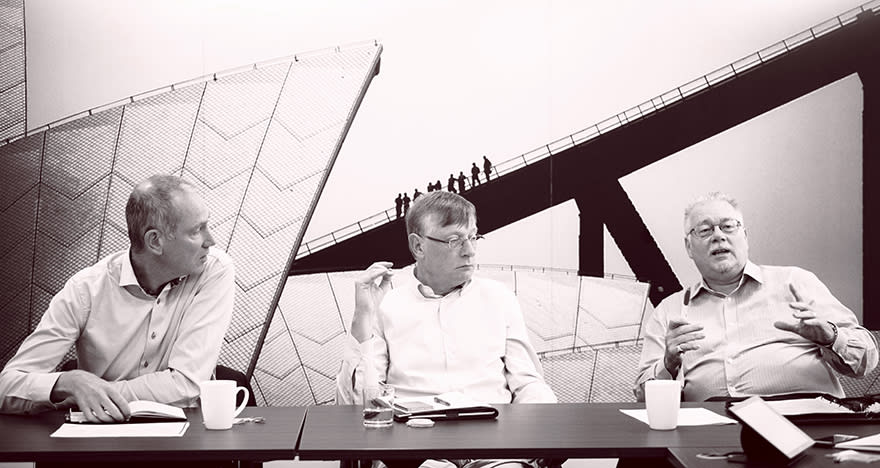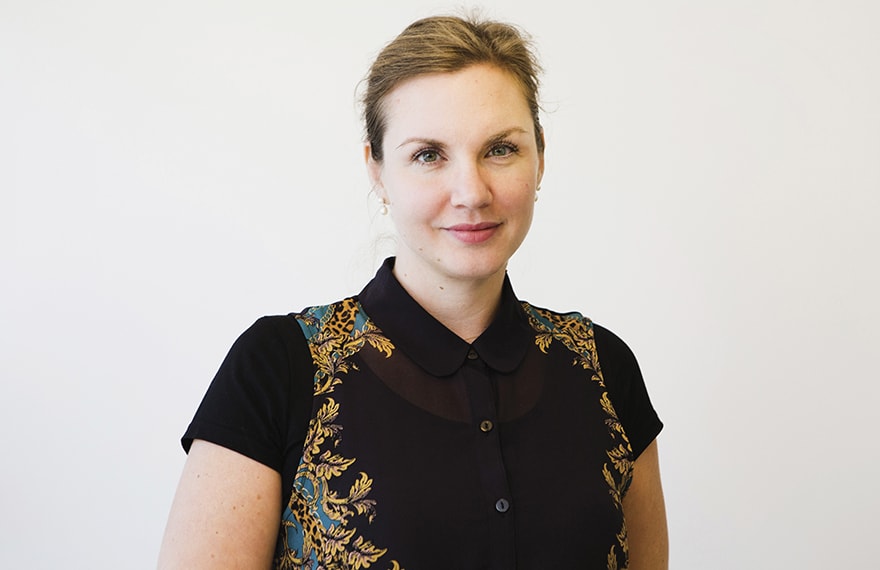The Centre for Digital Built Britain has organised a series of debates to examine whether the built environment is delivering on the Government’s digital programme. First up, senior figures from the academic sector gave their opinions on what is working, and what needs to change. BIM+ joined the debate.
Inconsistency across courses and certification, a lack of accreditation, a gap between academic tuition and industry needs and insufficient rigour in CPD programmes – these were just a few of the concerns highlighted by education professionals in a recent debate organised by the Centre for Digital Built Britain (CDBB).
The event, hosted at the Chartered Institute of Building (CIOB) central London office, was the first in a series of discussions which will involve all sectors of the industry, including contractors, consultants, FM providers and clients. CDBB will use the sessions to help understand how BIM is currently being adopted and to inform the future CDBB agenda.
Terry Stocks, leader of the CDBB BIM Level 2 workstream, launched the academia debate by observing: “Unless we have got a skilled workforce, and a skilled base that we are growing, it is going to be really difficult to deliver the government’s aspiration for a digital built Britain.”
One of the first issues raised was that BIM and digital training is too often separated from “core” built environment education.
“It is seen as a specialism; you train as a structural engineer or an architect, but then go off and do a separate BIM course,” says Gareth Sewell, BRE’s associate director for BIM. “But BIM and digital should be part of your daily job and, to reflect that, it needs to be integrated into training for every discipline.
“The training should also teach people to integrate with other disciplines. But most of the courses are separate. An architectural course is purely architectural and provides no contact with structural engineers, QSs, mechanical engineers or other roles.”

Paul Allford (right) says "standardisation is lacking”. Nigel Midmer (left) and Steve Pittard look on
The different professions in the industry are all at different levels of ability, adds David Greenwood, director and co-founder of the BIM Academy. “Architectural technologists are at the top, followed by construction; civil engineers are near the bottom.”
The potential “silo” effect in digital learning is a concern Iain Miskimmin has attempted to address as manager of the Crossrail-Bentley Information Academy, which has trained over 6,000 people.
“From the launch in 2012, we made sure people didn’t end up in silos according to their role and organisation,” he explains. “Whether they were a CAD manager or project manager, we concentrated on giving them the digital skills that they needed to use in their job from day to day. It wasn’t a bolt-on. We also called it the Information Academy rather than the BIM Academy to stress that this isn’t just about modelling – it’s about digital asset delivery.”
There is general agreement on this. “We are in danger of talking too much about BIM education when it is just one aspect of digital technology,” says Paul Allford, CITB qualifications and standards policy manager. “There is also AR, VR, drones, the internet of things and more.”
Karen Alford, who leads the Environment Agency’s asset data strategy, adds: “All we are talking about is doing the traditional things that have always happened but putting in some technology so it can be done smarter.”
“It is about making people aware of what tools are out there and how they can then be used,” says Rob Garvey, senior lecturer at the University of Westminster.
Another concern for Allford is “inconsistency” in courses at all education levels. “Standardisation is lacking – we need to define the skills sets required,” he adds.
This suggests we need a syllabus, says Fiona Moore, BIM Level 2 programme manager at CDBB. “We have one of sorts in the Learning Outcomes Framework, but it needs to be updated and adopted more widely,” she says.
“We need to ask, ‘what does it mean to be digitally literate?’,” says Julien Sample, assistant principal at Harlow College. “The Department for Education and Alpha Plus are doing some work on this, developing a set of digital standards for adults similar to literacy and numeracy. That might start to address the digital skills deficit.”

Eleni Papadonikolaki, UCL Bartlett School of Construction: “The school is looking at the construction industry from a client perspective; they need to learn the argument for digital.”
“So, if and when something like that is launched against the backdrop of Digital Built Britain it starts to create that bigger education picture,” says Stocks.
But aside from the lack of standardisation, there is concern around quality and relevance of course delivery.
“With research we carried out in Scotland, you could take 10 courses which had the same title across 10 universities and you would get 10 versions of what should be being taught,” says Allford. “That is down to having one lecturer who knows everything about BIM, so it gets packed into that course; while another lecturer doesn’t know much at all, so students will get very little BIM.”
It raised the tricky question of whether, Stocks asks, “educationalists are close enough to digital to deliver training?”
Sample believes the statutory sector has made great strides in digital education and says Harlow College has been able to get funding to send staff out into industry for specialist training with engineering companies. “When they come back they are then at a level where they can pass that knowledge on,” he explains.
Greenwood adds: “Increasingly at the very top levels, with PhDs or engineering doctorates, we are seeing a trend of increasingly involving industry, which is great.”
But he also feels there is a “big barrier” to training the trainers. “You have got to either bribe, seduce, or scare staff into getting good at these things by either grants or something like the 2011 BIM mandate for digital education,” he says.
However, South Bank University’s BIM lead Steve Pittard argues that apprenticeships can play a role in bringing industry and academia closer together.
“If we spent a bit more time trying to make the apprenticeships work rather than using it as a cash cow to fund part-time degree courses, it could help bring these digital skills into the industry,” he says.
“We academically train people but it has to be relevant to what they end up doing. It takes time to get them to a point where they are useful in the industry.”
Sewell believes that the absence of the mentoring process is partly a cause. “That has gone and it used to be key when you started in construction,” he says. “We need to link academia, apprenticeships and mentoring together.”

Thomas Harrison, BSI: “The 2016 mandate wasn’t the end of a journey towards BIM, it was the start”
“We can learn in academia but it is not until you get into the real world and actually start working that you can learn what the industry actually needs,” says Niraj Mistry, head of BIM at certification body Stroma.
Though Greenwood says: “The role of vocational courses in the academic world is to protect people from the real world. So they can learn.”
ISG’s national framework director Sarah James provides perspective on how “digital ready” new graduates are on joining the contractor. “We are seeing the newer students coming through who are much more comfortable with digital side, but a big variation with who is coming through,” she explains.
Eleni Papadonikolaki, BIM lecturer at the UCL Bartlett School of Construction, says both her undergraduate and postgraduate programmes have components of digital and BIM. “At the postgraduate level, it is more optional, but for the undergraduates it is skill based and it is mandatory for second years,” she explains. “The school is looking at the construction industry from a client perspective; they need to learn the argument for digital.”
“Does the industry feed through to academia its BIM requirements?” asks Stocks.
Mistry says he is working with the BIM4 communities, which aim to understand the competency requirements for industry sectors by getting feedback from special interest groups.
“With water, for example, there are assets which will be around for quite a long time so there is a massive amount of information to be managed,” he explains. “But then rail will have its own specialist requirements.”
“I am working with 78 companies, half of them Tier 1 contractors, but the feedback I get is that they don’t know how the current standards apply or even understand the information that is passed down to them from their employers.”
Is this where CPD has a role to play? “We have talked about younger people entering construction but we need to address the professionals already working in the industry,” says Nigel Midmer, digital chair of the National Association of Construction Frameworks (NACF).
“CPD is a really important vehicle but if it is not getting the message out, then what is the point in it?” says Garvey.
Moore asks: “Is it true to say that a lot of the CPD-type education to date has been based on BSI standards and an understanding of them rather than an application of them to the real world?”
“It is about an application of the process, not just reiterating what the standard says,” Sewell replies.
“The BIM4 communities are doing the best they can but they are staying within the regional groups,” says Midmer. “There isn’t a feed from central government going down, so they aren’t able to ask questions.”
“I’m looking for a single source of truth that we can all reference to provide scalable training programmes – that way we can create an educational process all the way through the age groups.”
Stocks summarises: “So what I’m hearing is that we need to define a digital set of capabilities which educational institutes can draw down from, whether for CPD, a vocational course, or a PhD.”
But, he adds, how do we measure the success of a digital education? Although there are certifications available for digital training, none are accredited.
“Would accreditation of that certification make it more useful?” asks Moore. “We are talking about standardising an education here so that it isn’t every organisation’s opinion of what an education is.”
On this there is agreement across the board.
Digital training in statutory education
Harlow College’s Julien Sample says that he has seen “definite improvement in the development of digital skills” at school level and it is “constantly improving”.
“As they move into further and higher education and then into work, there will be that natural improvement in digital knowledge in the industry,” he adds.
“If statutory education is providing young people with a better level of digital awareness, then we need to enhance it, and make sure we don’t flatten it,” says CDBB’s Terry Stocks. “They could go into a traditional construction organisation and lose those skills.”
He asked the academia panel what else could be done to enthuse schools about DBB.
Bentley’s Iain Miskimmin observed how successful the Bloodhound Supersonic scheme had been for engaging schoolchildren with engineering.
“Who doesn’t like sticking a rocket motor up the backside of a car and flying it across the playground?” he says. “Everyone wants to be an engineer after experiencing that, but they want to be an automotive engineer – not a civil engineer.”
“So we need a Bloodhound for DBB,” says Stocks.
“We are starting to do that at ISG,” says Sarah James. “We will bring groups of schoolchildren in to redesign our office or see who can build the strongest bridge or tallest tower. We are only one step away from doing a digital version of that.”
UCL’s Eleni Papadonikolaki adds: “We have an academy at Swiss Cottage and the engineering department teaches about digital modelling, 3D printing, laser cutters and CNC machines. It is exciting to see students at high school working with these tools.”
Takeaways for academia from the debate
- An exciting vision of a digital built Britain – to encourage new entrants into construction.
- A “Bloodhound” programme for construction in schools.
- Ensure young people’s digital learning is nurtured and progressed post statutory education.
- Professional institutions need to insist on digital, BIM and collaborative content in courses.
- Courses should be accredited to ensure consistency of message.
- Academic leads should be supported by industry to maintain industry knowledge.
Comments
Comments are closed.














Yet another talking shop. But who is actually going to do it and make it happen? The demographic crisis is looming, young people aren’t interested in our industry. Class of Your Own and The B1M.com show the way to do it!